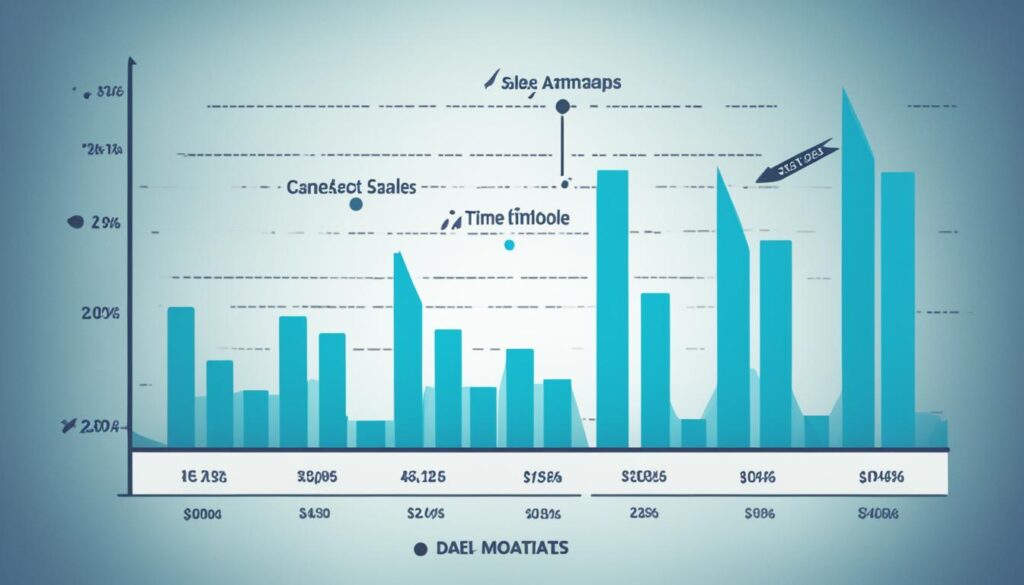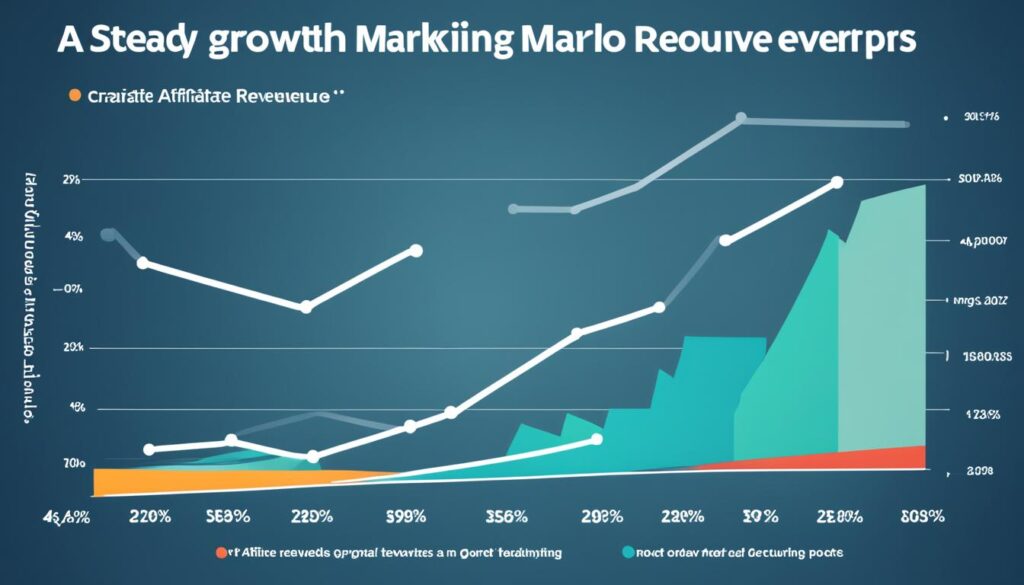Affiliate marketing has grown a lot recently. In the US, its market value hit $8.2 billion in 2022, rising from $5.4 billion in 2017. To do well in affiliate marketing, tracking the right key performance indicators (KPIs) is key. These KPIs show how well your marketing campaigns are doing. They help check on affiliates’ performance, watch for growth, and make things better. In this article, we’ll look at the top 10 important KPIs for affiliate marketing. These are what every marketer needs to watch to sell more and succeed in their strategies.

Key Takeaways:
- It’s vital to track affiliate marketing KPIs to see if you’re succeeding and making improvements.
- The conversion rate shows the share of visitors who take the action you want.
- Looking at sales per affiliate lets you see how individual marketers are doing.
- Keeping an eye on the portion of active affiliates helps ensure your program does well.
- Customer lifetime value (CLV) tells you how valuable the customers you get through affiliate programs are.
Conversion Rate
The conversion rate is key in affiliate marketing. It shows the percentage of visitors who do something we want, like sign up or buy something. This helps marketers understand if their campaigns are working well.
To find the conversion rate, divide conversions by visitors and multiply by 100. For instance, 100 conversions from 1,000 visitors means a 10% conversion rate.
By tracking conversion rates, marketers learn which ads work best. This helps them use their budgets wisely and reach the right customers.
A high conversion rate means marketing efforts are paying off. It shows that messages are hitting the mark, getting people to act. Boosting the conversion rate helps gain more customers and improves profits.
“The conversion rate is a fundamental metric in affiliate marketing that directly impacts the campaign’s performance and profitability. By continuously monitoring and optimizing the conversion rate, marketers can ensure that their affiliate marketing efforts deliver the desired results.”
Tracking Conversion Rate
To track the conversion rate well, marketers need the right tools. They use special platforms that show detailed conversion data.
These systems link conversions to the affiliates that brought them. This shows which affiliates are most effective. It’s crucial for improving campaigns and rewarding top affiliates.
Optimizing Conversion Rate
To boost the conversion rate, marketers can:
- Optimize Landing Pages: Make landing pages attractive and clear. They should spell out the benefits and guide people on what to do next.
- Improve Call-to-Action (CTA): Use strong CTAs to get people to act. Make them stand out and sound appealing.
- Test and Iterate: Keep testing different elements like headlines and colors. This helps find what works best through A/B testing.
- Enhance User Experience: Make sure your site is easy to use, fast, and works well on mobile devices. A good user experience boosts conversion rates.
With these tactics and careful tracking, affiliate marketers can improve their campaigns. This leads to more conversions and higher income.
Sales per Affiliate
Sales per affiliate is key when you check how well an affiliate program works. It helps businesses see which affiliates bring in more sales. Plus, it points out the high achievers in conversions.
Each affiliate’s sales show how much they add to the program’s success. By watching these sales, companies know who are their star players. They then use resources wisely to boost sales and make more from **affiliate marketing revenue**.
Knowing sales per affiliate makes setting goals easier. This way, companies can reward affiliates to do even better. And bring in more sales.
Keeping an eye on this metric reveals ways to upgrade **affiliate marketing performance**. Spotting the stars and adopting their methods can make the whole team perform better. And share these wins to inspire success.
To show why this matters, look at this example:
“Sarah, an affiliate for XYZ Company, made 100 sales last month, earning $10,000. Meanwhile, John only had 20 sales, bringing in $2,000. Seeing their sales per affiliate, it’s clear Sarah does better, bringing in more money for the company.”
By spotting top-performing affiliates, companies can work more closely with them. And help them sell even more.
Affiliate Performance Table
Let’s dive into our best affiliates’ **performance metrics**:
| Affiliate Name | Number of Sales | Affiliate Revenue |
|---|---|---|
| Sarah | 100 | $10,000 |
| John | 20 | $2,000 |
| Emma | 50 | $5,000 |
| Michael | 30 | $3,000 |
This table clearly shows each affiliate’s sales and money made. From this, companies can decide the best next steps. And how to max out **affiliate marketing performance**.
Now, let’s talk about the percentage of active affiliates. This shows how involved affiliates are in the program. It also lets businesses see how their affiliate marketing is overall doing.

Percentage of Active Affiliates
In affiliate marketing, the number of active affiliates shows how engaged they are. It’s key for measuring success. Businesses check how many affiliates are really working to boost sales or leads. This helps them see if their affiliate program is doing well.
Having engaged affiliates is super important. When affiliates are busy promoting, more sales happen. So, businesses need to track this carefully. Keeping an eye on active affiliates helps improve strategies.
It’s also vital to spot the top performers. Businesses can find out who brings in the most sales. Then, they can support these stars to do even better. This leads to greater success for everyone.
Enhancing Affiliate Marketing Engagement
To better engage affiliates, businesses can try different tactics:
- Regular Communication: Talking often with affiliates through emails, webinars, or social media can build community and keep people involved.
- Providing Resources: Giving affiliates what they need to promote things can make them more effective and engaged.
- Offering Incentives: Rewards or special commissions can drive affiliates to do more and bring in sales.
- Tracking Performance: Watching how affiliates do and giving feedback can help them get even better.
These steps can help create a strong affiliate community and make marketing campaigns win.

Customer Lifetime Value (CLV) of Customers from Affiliate Programs
In affiliate marketing, Customer Lifetime Value (CLV) is key. It tells the total value a customer brings over their life. Businesses look at CLV to see if their affiliate programs bring in good, loyal customers.
CLV helps set goals for affiliates and improve marketing strategies. It shows where businesses can up customer value.
By keeping an eye on CLV, companies aim to keep high-value customers. This brings long-term wins in affiliate marketing.
“CLV analysis helps businesses see if they’re getting good, loyal customers from affiliate programs.”
CLV matters for keeping customers and earning their loyalty. Spotting customers with high CLVs lets businesses focus their marketing. They aim for strong, lasting bonds.
It’s vital to watch CLV as well as other metrics. This ensures affiliate marketing strategies work well. Attracting high-value customers leads to growth and profits.
Benefits of Measuring Customer Lifetime Value in Affiliate Marketing
CLV has big benefits for affiliate marketing:
- It spots the most valuable customers. This helps in planning where to put resources and rewards.
- Understanding customer value lets businesses fine-tune their affiliate strategies, boosting campaign results.
- Targeting high CLV customers improves loyalty and lowers churn.
How to Calculate Customer Lifetime Value
Different businesses calculate CLV in diverse ways. A basic CLV formula looks like this:
CLV = (Average Purchase Value) x (Average Purchase Frequency) x (Average Customer Lifespan)
Let’s break down the formula:
- Average Purchase Value: What a customer spends on average.
- Average Purchase Frequency: How often they buy in a time frame.
- Average Customer Lifespan: How long they stick around.
Calculating CLV offers insights into customer value. This supports smarter decisions in affiliate marketing.

Customer Lifetime Value Example:
Here’s an example of CLV in action:
| Average Purchase Value | Average Purchase Frequency | Average Customer Lifespan | Customer Lifetime Value (CLV) |
|---|---|---|---|
| $100 | 4 | 3 years | $1,200 |
In this case, each customer is worth $1,200 over three years. This is from buying four times a year, at $100 each time.
Tracking and bettering CLV helps focus on high-potential customers. This boosts profits and affiliate marketing success.
Average Order Value
In affiliate marketing, it’s essential to know the average order value (AOV). It tells us the average amount spent on each order. This figure helps us see how much money we make from affiliate sales.
To find the AOV, just divide total revenue by the number of orders. This calculation gives insights into how customers shop. It shows which affiliates bring in shoppers who spend more.
A higher AOV means customers are spending more on their purchases. This can lead to more money made, even with fewer orders. It shows that customers are willing to spend more. This opens doors to selling them more products or services.
Keeping an eye on the AOV lets you see which affiliates are bringing in big spenders. This helps you tweak your affiliate marketing to do even better. You might focus on certain affiliates, improve your ads, or make special offers to raise the AOV.
You can also use AOV to see how well each affiliate is doing. It lets you compare different marketing methods too. Understanding your AOV helps set up rewards based on performance. This way, you can spend your marketing budget more wisely to make more money from affiliate sales.
| Benefits of Monitoring Average Order Value | Tactics to Increase Average Order Value |
|---|---|
|
|
By focusing on and improving the average order value in your affiliate marketing, you can boost your profits. This attracts customers who spend more. Ultimately, it helps your business grow steadily.

Cost per Affiliate Sale / Cost per Lead
Cost per affiliate sale (CPA) or cost per lead (CPL) tracks the expense of gaining a customer through affiliate marketing. It’s calculated by dividing total affiliate marketing costs by sales or leads. This figure helps judge how cost-effective campaigns are and aids in budget setting and ROI optimization. Monitoring CPA or CPL is key to tracking and refining affiliate marketing effectiveness.
To get true CPA or CPL figures, include all costs of affiliate marketing. Count both direct costs like commissions and indirect costs like staff salaries. This full picture is crucial for precise measurement.
Understanding CPA or CPL offers insights into affiliate marketing campaign effectiveness. It shows which programs and channels are most cost-efficient. Focusing on these can boost ROI and campaign outcomes. By comparing different affiliates, businesses can wisely allocate their budgets.
However, it’s not just about finding the lowest CPA or CPL. The quality of leads or sales matters too. Leads must convert to long-term customers and generate meaningful revenue. Pair CPA or CPL with indicators like customer lifetime value for a full campaign assessment.
Regularly reviewing and adjusting CPA or CPL helps businesses get better at affiliate marketing. Efficient resource allocation based on solid data leads to success in this competitive arena. It’s about making smart decisions based on figures, not just feelings.
Let’s see a real-life CPA or CPL measurement:
| Affiliate Program | Total Cost | Total Sales | Total Leads | Cost per Sale (CPA) | Cost per Lead (CPL) |
|---|---|---|---|---|---|
| Affiliate Program A | $10,000 | 500 | 1,000 | $20 | $10 |
| Affiliate Program B | $8,000 | 400 | 800 | $20 | $10 |
Example Analysis:
Affiliate Program A and B both show a CPA and CPL of $20 and $10, respectively. But, Program A got more sales and leads than B. With identical CPA and CPL, more resources might go to Program A for its higher volume.
It’s key to look at CPA or CPL alongside other indicators, like revenue and customer value. This gives a richer view of an affiliate’s impact. It’s about the big picture, not just individual metrics.

Overall Engagement
Measuring the success of your affiliate program is key. Overall engagement is a crucial measure to look at. It shows how well affiliates connect with their audience.
By looking at how long visits last, how many pages people see, and other signs of interest, you get a clear picture of traffic quality. These insights help understand the affiliate audience better.
Keeping an eye on overall engagement helps you see how loyal your audience is. Spotting top performers lets you build a strong affiliate community. This community will promote your brand and improve your marketing efforts.
It’s vital to create a connected affiliate community. This fosters cooperation, sharing of knowledge, and support. Initiatives like meetups and forums help affiliates connect and learn from each other. This boosts engagement further.
Consider this quote to grasp overall engagement’s value in affiliate marketing:
“The success of an affiliate marketing program lies in the engagement between affiliates and their audience. By fostering a sense of community, understanding the interests and needs of the audience, and optimizing for engagement metrics, businesses can create a powerful affiliate network that drives impactful results.” – Jane Smith, Affiliate Marketing Expert
Benefits of Monitoring Overall Engagement:
- You can assess the quality of traffic generated by affiliates.
- Identify affiliates who consistently drive high engagement.
- Build a loyal and supportive affiliate marketing community.
- Increase the reach and impact of your affiliate marketing efforts.
- Enhance collaboration, knowledge sharing, and learning among affiliates.
By prioritizing overall engagement, you can strengthen your affiliate program. A robust affiliate community leads to significant results.
Top Metrics for Measuring Overall Engagement
| Metric | Description |
|---|---|
| Visit Duration | The average time visitors spend on the affiliate’s website. |
| Number of Pages Visited | The average number of pages visitors navigate on the affiliate’s website. |
| Engagement Rate | The percentage of visitors who interact with the affiliate’s content, such as social shares, comments, or form submissions. |
| Conversion Rate | The percentage of visitors who complete a desired action, such as making a purchase or filling out a lead form. |

Rate of Return / Rate of Cancellation
In affiliate marketing, tracking the rate of return or cancellation is crucial. It tells us how well promotional efforts are working and if customers are happy. Knowing how many customers return or cancel their purchases is key for business success.
A low return or cancellation rate means the marketing is effective, and customers are satisfied. Keeping an eye on this number shows where to boost marketing and make customers happier.
Finding out why customers return items or cancel services helps companies get better at marketing. They can also improve their products and customer service. This approach builds trust and strong customer relationships in the affiliate marketing world.
Measuring the Rate of Return
To measure return rates, compare returned purchases with the total affiliate sales. This helps understand what customers like or dislike about a product.
Keeping track of returns helps find product issues or mismatches in advertising. Fixing these problems can make customers happier, cut down on returns, and boost affiliate marketing results.
Measuring the Rate of Cancellation
Measuring cancellations is also important for campaign success. Calculate the cancellation rate by comparing it to total affiliate sales. This shows if marketing efforts are working.
A high cancellation rate might point to problems like misleading ads or complicated checkout processes. Identifying these issues allows businesses to fix them, better their marketing, and reduce cancellations.
Improving return and cancellation rates is key for customer happiness and business growth. By always working on these areas, companies can do better in marketing, keep customers happy, and reach their goals.

Revenue
Revenue measures the total money made through affiliate marketing. It shows if affiliate programs are profitable. By looking at revenue, companies can set goals and improve their strategies. This way, they make better decisions to increase their earnings from affiliate marketing.
Affiliate marketing revenue shows if a program is working well. Tracking it helps businesses see how well they are doing. This helps companies understand how to make their affiliate programs better.
Success in affiliate marketing is not just about making money. It’s also about seeing if the program is really profitable. Businesses calculate affiliate marketing profitability by comparing income to costs. This helps them see if their efforts are paying off- if their investment is worth it.
It’s important to measure revenue correctly to improve affiliate marketing. With good tracking, companies can see which affiliates bring in more sales. This helps them focus on the right partnerships for better results.
Also, by monitoring revenue, businesses learn which ads and campaigns work best. They can then use their resources more wisely. This approach helps companies grow their affiliate marketing success over time.

| Key Metrics | Revenue |
|---|---|
| Affiliate Marketing Revenue | $X million |
| Affiliate Marketing Profitability | X% |
Growth Year-on-Year
Year-on-year growth shows how well affiliate marketing programs are doing. It tells us how much sales or revenue went up or down compared to last year. This helps businesses see how successful their marketing plans are.
This important metric helps find what needs to get better. It guides companies in making smart choices for growth. Setting real goals and checking how well marketing efforts are working is key. This way, businesses can improve their plans.
Keeping an eye on growth every year helps stay on top of the game. It leads to success in the competitive world of affiliate marketing. By focusing on data and performance, companies can make the most of their affiliate programs.